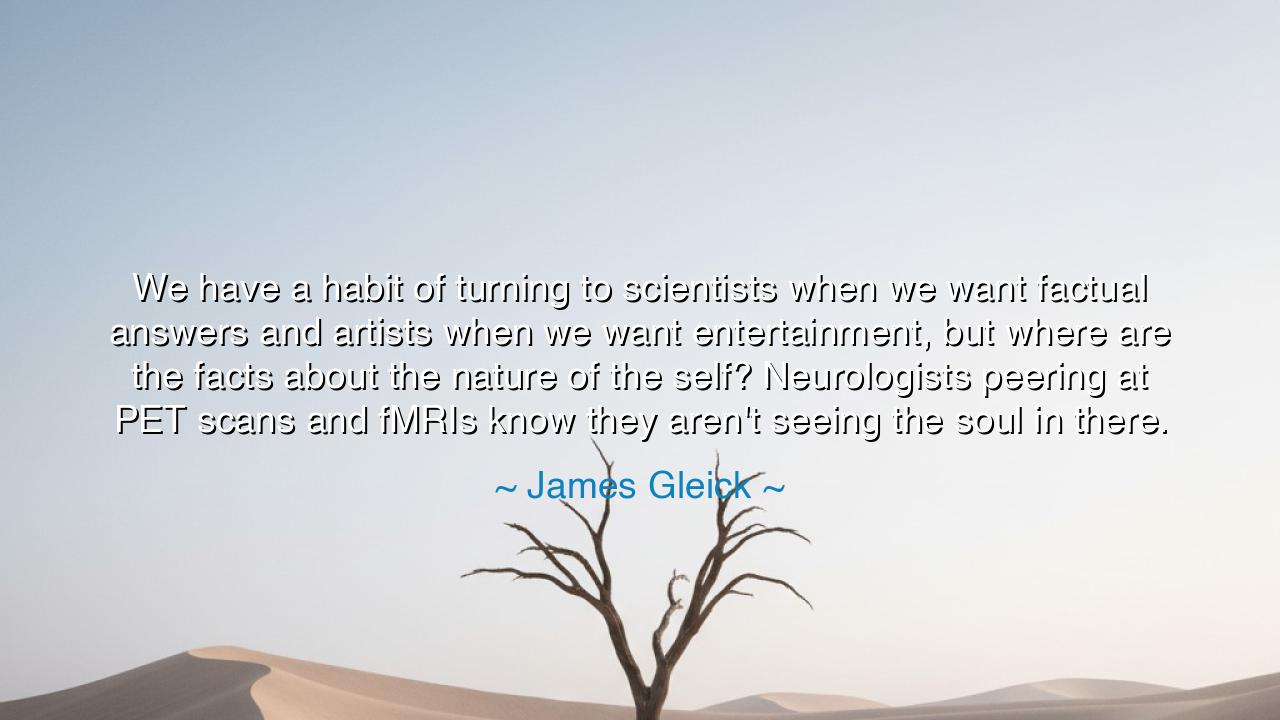
We have a habit of turning to scientists when we want factual
We have a habit of turning to scientists when we want factual answers and artists when we want entertainment, but where are the facts about the nature of the self? Neurologists peering at PET scans and fMRIs know they aren't seeing the soul in there.






James Gleick once declared with piercing insight: “We have a habit of turning to scientists when we want factual answers and artists when we want entertainment, but where are the facts about the nature of the self? Neurologists peering at PET scans and fMRIs know they aren’t seeing the soul in there.” These words strike at the core of the human dilemma: the search for truth about what we truly are. For while science dissects the flesh and art kindles the imagination, the deepest mystery—our essence, our consciousness, our soul—remains hidden from both microscope and canvas.
The first truth in this saying is the division of authority. When we desire certainty about the world, we turn to the scientists, those who measure, quantify, and prove. When we crave delight, beauty, or catharsis, we turn to the artists, those who inspire, evoke, and create. Yet in this division we overlook a third realm: the inner truth of the self, the question of identity and existence. Neither laboratory instrument nor stage performance can capture the totality of what it means to be alive, aware, and filled with wonder. Thus Gleick reminds us of the gap, the uncharted space between data and imagination, where the mystery of the soul abides.
The ancients themselves wrestled with this riddle. Plato spoke of the soul as immortal, divided into reason, spirit, and desire. Aristotle sought to classify life, yet admitted that the animating principle of man could not be weighed as flesh. In the East, sages of India proclaimed the Atman, the eternal self beyond body and mind. Across ages and cultures, thinkers confessed the same: though we can name the stars, chart the seas, and master the elements, the deepest truth—what it means to be—remains veiled. Science and art alike fall short of piercing the heart of consciousness.
History offers us examples of this longing. René Descartes, dissecting animals in pursuit of truth, declared “Cogito, ergo sum”—“I think, therefore I am.” Yet even as he reasoned thus, he admitted that the true self was not body nor even thought, but the essence that perceives. In modern times, neurologists mapping the brain find sparks of activity, glowing images on fMRIs, yet these are shadows of process, not the substance of personhood. They see the instrument, but not the music; the wires, but not the current. As Gleick says, no scan reveals the soul.
The meaning of this truth is profound: man’s longing for certainty must be tempered by humility. We must honor the work of science, but not mistake it for revelation of the self. We must cherish the gifts of art, but not believe they exhaust the mystery of existence. For the soul dwells beyond what can be measured and beyond what can be performed. It is glimpsed in silence, in wonder, in the trembling awareness that we are more than flesh, more than thought, more than spectacle.
The lesson, then, is luminous: do not seek the fullness of your identity in charts, nor in applause. Seek it instead in reflection, in discipline, in the humble recognition of mystery. Honor both scientists and artists, but also learn to sit in the space between them, the space where neither facts nor fantasies suffice, and where the unnamable essence of being waits to be acknowledged.
Practical action follows. Cultivate curiosity for the findings of science, but do not demand that they explain away the soul. Drink deeply from the cup of art, but do not mistake beauty for the whole of truth. Instead, practice stillness. Ask yourself: Who am I, apart from my body, apart from my roles, apart from my possessions? Live with reverence for the mystery of existence, and let humility guide you when certainty fails.
Thus James Gleick’s words, though spoken in an age of machines and images, resound like the teaching of an oracle: The self is not found in the laboratory, nor upon the stage, but in the hidden sanctuary of being. Learn to honor the mystery of the soul, and you will walk with wisdom. For though the world may never reveal all its secrets, the search itself shapes us into seekers worthy of truth.






AAdministratorAdministrator
Welcome, honored guests. Please leave a comment, we will respond soon